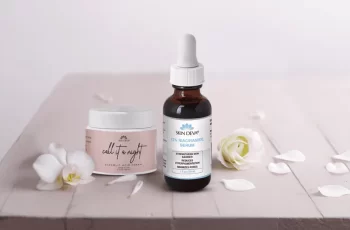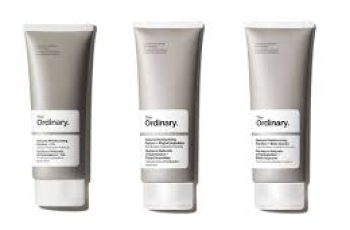Chemical Peels
When it comes to chemical peels, I’m a big fan and I rely on semi-regular chemical peels to maintain my skin. My go-to is a Jessner – a combination of Lactic Acid, Salicylic Acid, and Resorcinol – to keep my breakouts and pigmentation under control and help with general aging concerns.
Because I have done regular peels, I know exactly what to expect and how my skin will respond. I can arrange my schedule accordingly to accommodate the pre-treatment requirements as well as the recovery and it always goes well. But I have also had a bad experience when a chemical peel was added to a facial without my knowledge or consent. It was considered light but the ingredient did not agree with me and I ended up with very unhappy rough, itchy, dry, red skin that took a few weeks to clear up.
I am not here to scare anyone away from chemical peels – as I said, I am a fan – but I firmly believe that any peel, regardless of concentration, should be managed as a medical procedure with proper consultation and prep in order to avoid anyone experiencing a reaction as I did. Chemical peels are to be respected and it’s best to understand what they are about before getting one done.
What is a chemical peel?
Chemical peels are exactly what they say they are – a chemical treatment that “peels” or, rather, stimulates a stronger shedding response in the skin than everyday skin care products. The ingredients that make up a peel determine how deep into the skin the treatment penetrates which then affects the intensity of shedding as well as the length of recovery or downtime. Chemical peels help treat a variety of concerns – pigmentation due to sun damage, acne and congestion, fine lines and wrinkles, texture and scarring – and there are a lot of options to choose from depending on what skin concern is being targeted.
Peels are generally categorized as light (stimulating the very top layer of the skin only and are considered superficial. Think ‘lighten, tighten, brighten’), medium (penetrates deeper into the epidermis to treat congestion and pigmentation), and deep which claim to penetrate to the dermis and are for severe cases of sun damage, pigmentation, and wrinkles.
glycolic acid
What can you expect?
Typically, regarding a mild or medium peel, you can assume visible dryness, obvious shedding, dullness, and this can go on for several days. If full-face makeup is part of your daily routine, it likely won’t sit on your skin smoothly. What can also happen is a purge. If you are prone to breakouts, a chemical peel can exacerbate this and encourage MORE blemishes. Pigmentation can start to look darker and in some cases, I have seen pigmentation appear where it wasn’t visible before. Feedback to clinics from patients can often be, “you made my skin worse”.
It is true that for 1 to 3 weeks (possibly longer for a deep peel), you aren’t going to like your skin very much and this is a terrible feeling, but it is temporary. Remember that the peeling, the purging, the pigmentation coming to the surface are all good things! This is all exactly what a chemical peel is supposed to do and exactly what needs to happen. But keep in mind that it is very common to require more than one peel treatment to see dynamic results – I call it peel, purge, perfect – since it can take a few cycles to get pigmentation and deep congestion up and out.
My personal peel response from my go-to medium-depth peel is always 3-5 days of dry (and I mean DRY), flaky skin followed by a week or more of breakouts. After that, The Glow. I love it. But I would be lying if I didn’t admit that literally every time I do a peel I get nervous that my skin won’t recover. It always does.
Remember that the damage we are trying to correct didn’t happen overnight and there is no quick fix; it is rarely a case of one-and-done. Wear your sunscreen, avoid over-scrubbing and too many irritating ingredients in skin care. Chemical peels are a fantastic boost to your daily efforts and there is an option for just about everyone.
Trust the process.
salicylic acid structure
Regulations for chemical peels
There are also different regulations regarding peels depending on the ingredients. Some require no medical supervision – think enzyme peels – while others are considered prescription and must be applied by a physician. My general advice is to have a peel treatment done at a medical facility regardless, especially if it is your first experience.
So, why do they need to be respected? These are concentrated solutions of ingredients designed to aggravate and inflame your skin and some treatments often contain ingredients you likely haven’t come across in your daily skin care. Even if you have – perhaps Glycolic, Lactic, or Salicylic Acids – it would be in vastly lower percentages and, therefore, not as aggressive.
I compare it to lifting weights – you can pick up a 5lb dumbbell and do some lifts and it won’t be too challenging. Now, pick up the 100lb weight and do the same exercises. Your body is going to have something to say about the increase in weight. You can look at chemical peels the same way.
In preparation for a chemical peel, if possible, I recommend a test patch at least 24 hours before your treatment – a small area along your jawline where the peel is applied; this will help rule out any possibility of reaction. A test patch won’t always be an option but it is good practice to inquire. Discontinue active ingredients such as Retinol, Glycolic or Lactic Acids, and scrubs 3-5 days before your appointment. Stay out of the sun as much as possible, hydrate, and avoid any hair removal – waxing, depilatories, or shaving. Post-treatment instructions are similar – no active skincare, avoid scrubs and sun exposure, wear sunscreen – but specific care instructions should be provided by your technician.
Upon application of mild and medium peels, patients can experience sensations from a light tingle to spicy heat while deep peels typically require numbing cream due to the aggressive depth of penetration.
Now, a lot of what I have laid out so far is not breaking new ground. In fact, information on peels can be found simply by Googling and a lot of clinic websites detail their chemical peel options well. What I have found to be lacking, however, is information on the recovery; that in-between time from getting the treatment done to enjoying the results.
DQH Knowledge drop: In your 20s, your skin cell turnover decreases. (Cell turnover is a key component in keeping your skin youthful.) You know what else slows down? Your collagen production. Starting in your 20s, collagen decreases by about 1 percent per year. Should you want to prevent fine lines and wrinkles, start by eliminating behaviors that contribute to premature aging. “If it’s bad for you, it’s bad for your skin,” says dermatologist Michel Somenek.
“Cigarette smoking reduces blood flow to the skin and causes premature wrinkling and a dull skin texture. Making the repeated pursed motion to inhale can also cause smoker’s lines. Alcohol and recreational drugs are toxins for the skin that damage its cellular structure and DNA,” Somenek tells us. “The faster you eliminate vices while you are young, the better chance your skin and body have to recuperate.” Also, adopting an anti-aging routine in your 20s is key. After all, the best offense is a good defense. We spoke to Somenek and experts Joshua Ross and Audrey Kunin to find out more.
Keep reading for the best anti-aging products for your 20s, according to skincare professionals.
Sunscreen
“We all know that the sun is the number one cause of skin aging and starting the prevention in your 20s is very important,” Ross says. “The majority of your sun damage won’t start to appear until you’re in your 30s, so don’t wait until you see it surface or you’ll be behind the curve. Stay ahead of it with a good-quality zinc-based sunscreen worn daily.”
Farmacy Green Defense Daily Mineral Sunscreen
An invisible sunscreen with SPF 30, plus botanical extracts meant to protect skin with tons of antioxidants. Bonus: It’s clean and fine to use under makeup.
Bareminerals Complexion Rescue™ Tinted Moisturizer Broad Spectrum SPF 30
Although we recommend you use your SPF and moisturizer separately, we also understand moments when you don’t have time or energy for that extra step. For those times, this bareMinerals moisturizer is a great thing to have on hand.
Vitamin C Serum
“A great introduction to anti-aging is to start with a vitamin C serum in your morning skincare routine,” Ross says. “It’s a powerful antioxidant that will neutralize free radicals and brighten the skin.” He adds that it’s a great way to counteract the effects of the sun’s harmful rays, which, as previously mentioned, are among the biggest causes of premature aging.
Drunk Elephant C-Firma™ Vitamin C Day Serum
The Drunk Elephant C-Firma is a lightweight serum that promises to give skin a glow by combining the brightening powers of vitamin C with ferulic acid, l-ascorbic acid, and vitamin E. The included sodium hyaluronate is meant to replace hydration loss, so you shouldn’t have to deal with any irritation.
Sunday Riley C.E.O. Rapid Flash Brightening Serum
This potent serum is jam-packed with vitamin C (15 percent, to be exact), which means it’s a potential superstar at both brightening skin and dousing it in antioxidants.
Peptides
Using peptides on your skin has many benefits, says Somenek. “The skin barrier is what defends the body against pollution, UV rays, bacteria, and toxins. It can be damaged by several everyday factors. Using topical peptides aids in building a stronger barrier,” he says. “Peptides comprise elastic fibers, which are a type of protein. These fibers help to make skin appear taut and firm. Peptides can also help repair damaged skin, relieve inflammation, and even out skin tone. Some peptides can kill acne-causing bacteria that is common in 20-somethings.”
Kunin agrees, saying, “Peptides are an excellent entry point for supporting collagen.” She recommends looking for face and eye treatments that contain these collagen-boosting powerhouses.
Charlotte Tilbury Magic Eye Rescue Cream
This Charlotte Tilbury super-emollient eye cream has a base of coconut oil and shea butter (read: it’s incredibly hydrating). Botanicals plus peptides are meant to help reduce dark circles and boost collagen, respectively.
This creamy moisturizer serves up potent collagen-boosting peptides and pycnogenol, and antioxidant-rich vitamin C. “Instead of sitting on top of the skin, peptides penetrate the outer layer so they go deep. The ‘signals’ they send tell the cells to produce elastin and collagen, which are needed for youthful-looking skin,” explains Somenek.
At-Home Peel Pads
Remember that skin cell turnover fiasco we talked about earlier? One way to help support it is by exfoliating. “Exfoliation is important to help keep skin fresh and luminous,” Kunin says. She recommends using at-home peel pads as an easy and effective way to exfoliate.
“The goal in your 20s is to fight the slowing pace of cell turnover. It is wise to use products that gently exfoliate, yet still remove oil and other impurities. Products that have Alpha Hydroxy Acids (AHA) or Beta Hydroxy Acids (BHA) are a good choice.”
According to Somenek, you should only exfoliate two to three times a week. “People of all ages are guilty of over-exfoliating and that can be too much of a good thing,” he says.
Dermadoctor Kakadu C Intensive Vitamin C Peel Pad
A few swipes of this Derma Doctor powerful peel pad promise to leave your skin glowing and smooth, thanks to the seven (yes, seven) types of chemical exfoliants, including AHA and BHA. It also contains vitamin C via Kakadu plum extract for added brightening and antioxidant protection.
KEY INGREDIENTS Kakadu plum extract is sourced from the Kakadu plum, a fruit grown in northern Australia. It contains vitamin C, which restores the skin’s natural barrier, increases collagen production, and soothes irritation.
Dr. Dennis Gross Skincare Alpha Beta® Universal Daily Peel Pads
These are the gold standard of peel pads, with a cult following and over 900 five-star reviews on Sephora. They’re easy to use and contain a blend of anti-aging exfoliating acids.
Emollient Night Cream
“In your 20s, you need to start upping the hydration in your skincare routine. You may have been cautious of over-moisturizing because of acne in your teens, but as you enter your 20s, your skin transitions and becomes drier,” Ross says. “I recommend an emollient night cream added into your evening skincare regimen.”
“Twenty-somethings need to make sure that they are not using creams that will clog their pores and cause excess oil production,” says Somenek. Opt for non-comedogenic products.
Cerave Skin Renewing Night Cream
One great choice is the CeraVe Skin Renewing Night Cream, which is a non-comedogenic night cream that leaves skin soft and glowy. It combines the moisturizing powers of ceramides and hyaluronic acid.
RoC Retinol Correxion Max Hydration Creme
“The best night cream ingredients contain retinol, benzoyl peroxide, and/or salicylic acid or hyaluronic acid. The goal is to moisturize, yet remove excess oil,” says Somenek. This Roc Retinol Correxion cream fits the bill as it contains both hyaluronic acid and retinol so it promises to moisturize while also being non-comedogenic.



